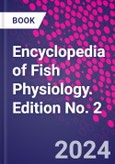Encyclopedia of Fish Physiology, Second Edition is a comprehensive, introductory-level reference work that aims to unite readers in the wonders of this discipline. Chapters highlight where physiological systems and processes are conserved across vertebrate groups, which supports the use of fish as a vertebrate model for investigating fundamental problems in physiology and knowledge transfer to the medical field. Other chapters highlight unique specializations and adaptations that allow fish to survive in challenging environments, leading to a deeper appreciation of the natural world. Final sections demonstrate the consequences of perturbing physiological systems and how this knowledge can empower conservation strategies to protect fish.
Much has changed in the field of fish physiology since publication of the previous, Prose award winning, edition. For example, we understand better the impacts of global climate change on the physiological systems of fish, and we have gained a deeper mechanistic understanding of physiological processes through technological advancements such as gene editing with CRISPR, whole genome sequencing, and quantitative 'omic` approaches. The new edition greatly expands the closing thematic section focused on applying fish physiology to real world challenges with topics including ocean acidification, declining habitat quality due to human activities, and the use of zebrafish in biomedical studies on tissue regeneration, neurological disorders and cancer.
Please Note: This is an On Demand product, delivery may take up to 11 working days after payment has been received.
Table of Contents
The Encyclopedia is structured in 3 volumes with 4 major sections that group topics and chapters thematically. This mirrors the structure of the first edition, but some topics have been reorganized and some new topics introduced. * indicates a change from the original edition.Volume 1: The Senses, Integrating Systems*, Behaviour, and Reproduction - this volume is about how fish interface with the world Sensing the Environment e.g. the brain and nervous system, vision, hearing and the lateral line, electroreception, olfaction Endocrine and Immune* Systems e.g. introduction to major hormone systems and their role in regulating physiological processes Behavioural Physiology e.g. predator/prey, reproductive behaviours*, dominance, schooling*, sleep, communication* - Reproduction e.g. reproductive strategies*, sex differentiation, early development*
Volume 2: Gas and Ion Exchange, Circulatory System, Energetics*, and Movement* - this volume is about how fish function internally Gas Exchange and Ion homeostasis e.g. respiration, osmoregulation, acid/base balance, structure and function of the gills and kidneys The Heart, Vasculature, and Blood e.g. comparative morphology, regulation of heart function, retes, blood cells, Root effect Energy Homeostasis e.g. food intake, digestive system, metabolism, excretion Muscles and Movement e.g. musculoskeletal system, biomechanics of swimming, locomotion, migration
Volume 3: Adaptations, Specializations, and Applications - this volume establishes the importance of fish physiology by placing it in the context of other disciplines Responses and Adaptations to the Environment e.g. hypoxia, thermal acclimation, seawater transition, bioluminescence Life in Extreme Environments* e.g. complete darkness (cavefish), subzero temperature (icefish), alkaline lakes (cichlids), intertidal fish Physiological Specializations of Different Fish Groups e.g. deep sea fish, air-breathing fish, elasmobranchs Applications of Fish Physiology e.g. biomedical applications (neuroscience*, regeneration*, disease models), food science* (aquaculture; petri dish sushi), toxicology, climate change*, conservation physiology*








